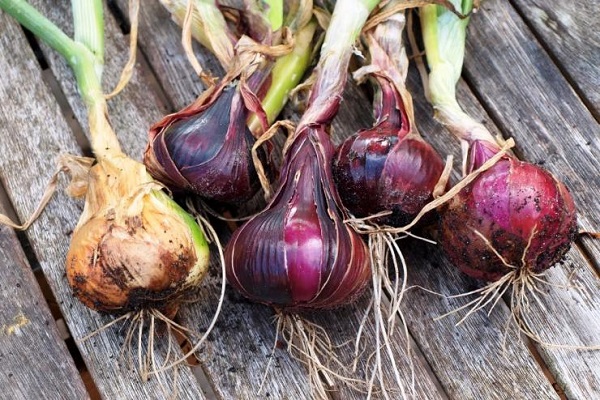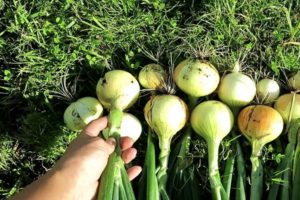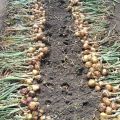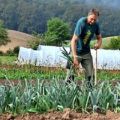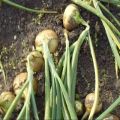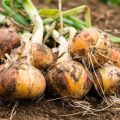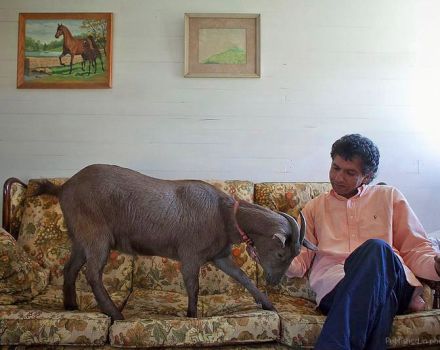When do you need to harvest onions in the Moscow region and the region in 2020 for storage?
Determining when to harvest onions in 2020 in the Moscow region is easy by external signs. The ripening period often depends on the weather conditions, the selected variety, and the characteristics of caring for the vegetable. Recently, it has become common to orientate to the dates indicated in the lunar calendar. The harvest on time retains all the valuable substances and is well stored for a long time.
Content
Determine if the onion is ready for harvesting
When determining the timing of planting and harvesting onions, they take into account the climate of the region, the peculiarities of agricultural practices, soil type and variety. In the Moscow region, winter crops begin to be harvested at the end of July. If the weather was warm, then on the 20th they begin to dig out the bulbs.
In the Moscow region, onions need to be dug up when the following signs appear:
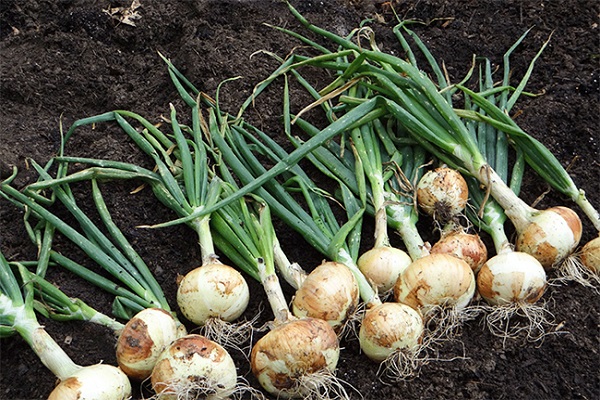
- feathers begin to turn yellow, dry;
- the neck of the bulb becomes thinner, dries and softens;
- the top, dry scales, golden yellow in color, easily depart from the bulb;
- the arrows are drawn out, the seed pods are cracking.
Usually bulbs ripen together. As soon as it has been noticed that 60–70% of the tops have fallen to the ground, you can start digging.
Correct and accurate determination of the timing of harvesting a ripe vegetable crop affects further storage:
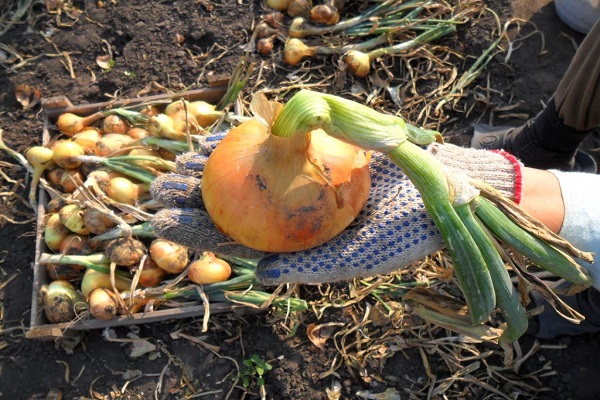
- If you do not allow the crop to fully ripen, then the bulbs will have unripe upper scales, the neck will remain firm, thick and juicy. Such onions will quickly sprout and rot.
- If the appropriate time for harvesting is missed, the vegetable will begin to take root, the head will begin to overripe, crack, which causes rotting.
You can calculate the harvest time with a simple mathematical example. It is enough to add 65–85 days to the day on which the onion was planted. The number of days added depends on the variety.
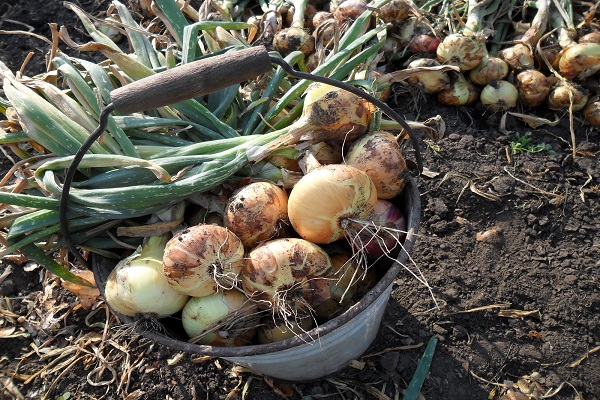
Preparing onions for harvesting
Onion harvesting in the Moscow region coincides with the last week of July. If by this time the feathers are still green and do not think to dry out, you need to help the vegetable to ripen. This is necessary in order not to get into the rainy season. The following activities will help speed up ripening:
- Two weeks before the expected digging, watering and loosening of the soil, as well as fertilization, are stopped.
- Gentle root pulling helps. If the soil is loose, you can pull the bulbs slightly by hand. In other cases, you can do this with a shovel. Digging a little head, leave in this position until fully ripe.
- Some growers carry out the procedure for exposing the bulb. The earth is raked away until half of the onion is exposed. This will allow sunlight and heat to reach the root crop without obstruction.

All these actions are aimed at reducing the supply of nutrients from the soil, and accelerating the maturation of the head.
Sometimes yellowing and drying may not be the main sign of a ripening crop. This happens in hot summers when there is no rain. Indeed, in the absence of precipitation, the plant begins to dry out. In this case, the vegetable should be watered as often as possible in the first two months after planting.
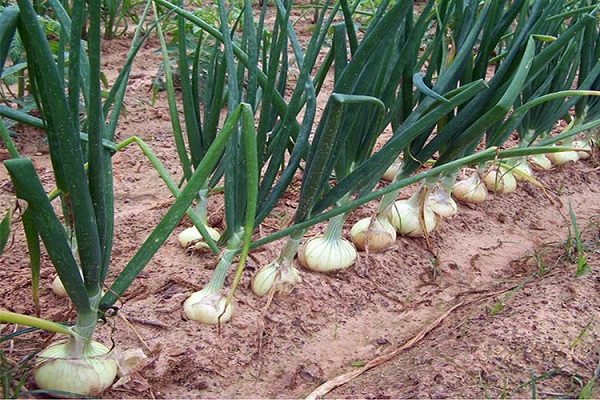
When and how to harvest onions in the Moscow region?
The warmer and drier the weather is in summer, the faster the vegetable crop will grow and ripen. The first month after planting is considered important, since the main development of plants and the increase in feathers occurs at this time. After the ground part of the plant is formed, the root crop begins to actively develop.
For harvesting a ripe crop, choose a sunny day so that the dug out onions can be dried in the open air, under the rays of the sun. If it rains, the bow is immediately removed under the roof.
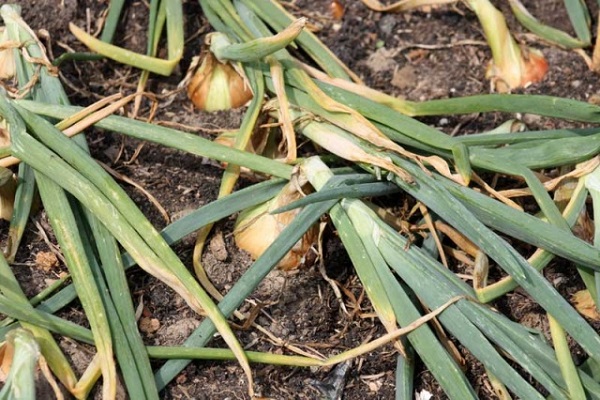
It is better to dig with a pitchfork or a shovel. Only this must be done carefully so as not to damage the bulb. It is recommended to retreat 10 cm from the garden bed and start digging in. Pulling the onion out of the ground by hand can damage the onion or tear the tops. After digging, shake off the adhering dirt, but do not beat the bulbs against each other, this can lead to damage.
Spread the collected onion on the prepared matter in one layer, periodically turning in different directions to the sun. At night, it is recommended to cover it with foil so that morning dew cannot damage the crop, or bring it indoors.

Feathers do not need to be trimmed, as useful substances accumulate in them. While the head dries, it ripens and is saturated with nutrients.
Drying
If the deadlines for harvesting onions in the Moscow region have been met, then there will be no problems. The onion heads will be dense, without damage, deformation, and after two weeks they will completely dry out.

There are several signs that can tell if the bulbs are dry. The scales of the head become dense, dry and rustle. You can examine the neck of the plant. When it is dry, then you can start cleaning for further storage.
The completely dried onions smell good, dense to the touch. Only after making sure that the bulbs are dry, they start trimming the leaves. Cut them off, leaving a stump of about 3-4 cm. If you intend to braid the braids from the tops, then cut the feather to 10 cm.

Storing onions in winter
Before moving the onion for storage, it is sorted out, selecting the deformed, damaged, with the presence of spots. It is used in food primarily. At the same time, seed can be collected.
Selected onions are placed in prepared containers. Plastic boxes, cardboard boxes, nets will do. The main thing is that they have holes for air ventilation. The containers are moved to a dry, cool place where the air temperature is about +3 degrees.

Collecting onions in the Moscow region is best in dry, windy weather. But it happens that summer does not please with warm days and vegetables are constantly in wet ground due to rains. If the onion heads are collected from too moist beds, then drying alone will not be enough.
The harvested crop must be additionally dried at higher temperatures (for 5 days at 33 degrees or for 8 hours at 42 degrees). Such bulbs are most often infected with rot and powdery mildew, which do not manifest themselves in any way during growth.

When to harvest onions in 2020 according to the lunar calendar in the Moscow region?
Sometimes, when harvesting a spicy vegetable crop, they are guided by the lunar calendar. It has long been noticed that in certain phases of the moon, the juices in plants are concentrated in different parts of it.When the moon becomes large, all the juices rush to the ground part of the plant; in the waning phase, all nutrients move to the underground part.
According to the lunar calendar for 2020, it is better to start harvesting in early August. The most favorable dates will be: August 2, 8, 13, 14, 20. These days coincide with the waning phase of the moon. The harvest collected on these days will dry well and quickly and be stored for a long time.
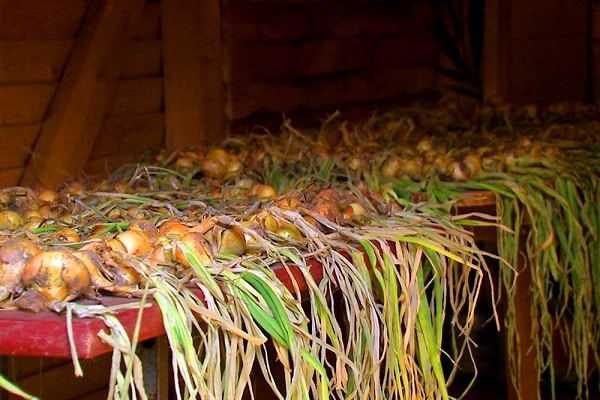
An unfavorable period for harvesting will be the days from 4 to 7 August. At this time, you can start loosening the soil.
Tips for harvesting and storing onions
It is necessary to remove the onions from the garden for storage correctly. By observing all the recommendations, it will be possible to reduce the risk of rotten heads and increase their shelf life.
You can determine the maturity of a vegetable by many criteria: according to the lunar calendar, in appearance, in a mathematical way. The main thing is not to dig up the onions earlier or later.

The best time to dig onions in the Moscow region is the end of June, beginning of August. After the vegetable has been dug up, it is best to leave it on the site. Under the rays of the sun, it dries quickly and well, at the same time it is disinfected.
If the soil is loose, then the head can be pulled out by hand without damaging the tops. In the case of dense soil, it is better to use a pitchfork or a shovel for work. Garden tools are stuck into the ground vertically at some distance from the entire garden. Digging up the ground, they try to pull out the bulb with their hand.

If the onion has to be removed from the moistened soil, then after digging it is washed, cleaned immediately from the husk and feathers, and the roots are cut off. Then they are laid out on a surface in a dry room that is well ventilated. After 2.5 weeks, a new layer of husk will appear and the bulbs can be stacked in storage containers.
Better to choose a cardboard box. This method of harvesting will preserve and provide long-term storage, up to summer.
During drying, you should monitor the condition of the onion neck. If it is soft, greenish, then the vegetable is not yet ready for storage. If the neck has become thin, dried out and turned yellow, then you can safely lay it out in the boxes. In this case, the harvest will be stored for a long time.
